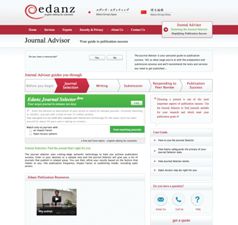Free tool helps with journal selection
Choosing which journal to publish your research in can be tricky and if English is not your native language it can be more difficult. Siân Harris finds out about a free, online tool to help with the task, whatever your native language is

Over recent years there has been a massive growth in research carried out in China and elsewhere and published in international, English-language journals. It is not an easy process for the authors of such research, however, according to Benjamin Shaw, global and China director of Edanz, an English-language service for researchers set up 17 years ago in Japan and which has had an office in Beijing, China since 2006.
‘Great science is coming from non-traditional markets. Publishers are finally waking up to the need to adapt,’ he explained. Edanz partners with a range of publishers, including Springer, the American Institute of Physics and BioMed Central to provide language services.
But there are challenges beyond language. Different cultures, writing styles and structures, and expectations all pose issues.
‘There is a different structure to literature and scientific papers and the logic is structured very differently, more like painting a picture in Chinese,’ noted Shaw, who added that there can still be different expectations of quality standards.
He described a typical researcher in China: somebody who has published more than 10 papers in Chinese journals but has much less experience of writing articles in English.
‘There is pressure to publish in English but he’s busy – he’s a surgeon too – and one advantage Chinese journals have is that they communicate to their authors in Chinese. Sometimes [western] publishers need to be reminded about the people who are publishing,’ he added.
Edanz has done workshops in many countries, including Iran, China and Brazil, and provides online advice videos, which it tries to provide to authors in their native languages. The Edanz Journal Advisor provides authors, especially non-native English speakers, with tools and services to help them overcome barriers to successful publication. It also includes guides and videos that inform authors about the publication process.
Selection challenges
There is another issue that Edanz has identified over recent years too. The challenge, which the company is serving to address with a new online tool within the Journal Advisor platform, is choosing which journal to publish in.
As Shaw explained, if you have not published in an English-language journal before and if you are not comfortable enough with English to read and consider the research published in different English-language journals regularly then it is very hard to know where your research would best fit.
‘A survey that we did on Science Net [a widely-used Chinese portal and social network for science] found that the number one challenge is finding journals to submit to,’ he observed. ‘A lot of authors are not reading a lot in their field in English – because they are busy or their English is not good enough – and they don’t know what to write or how to tell a story.’ He added that, when authors consider journals to publish in, they balance the sometimes competing demands of reaching their target audience and convenience.
According to Shaw, the typical approaches to choosing a journal include: looking at citations, but this is not comprehensive; asking colleagues, who may only turn to a small pool of titles; or searching publisher websites.
Edanz’ free-to-use Journal Selector aims to provide a more simple and thorough approach to addressing this. Journal Selector indexes over 18,000 journals and uses Parity Computing’s Semantic Profiling Engine to match an author’s research to journals that publish articles on similar topics using natural language processing.
Authors enter an abstract (if they have already written one), some keywords or some text from a similar paper into the tool and it comes up with a list of suggestions that can be narrowed by, for example, impact factor or publishing frequency. There are visualisation tools so that authors can see similar articles and when they were published. This helps them to know, for example, if similar papers have been published in the journal but not for several years, said Shaw.
Currently, the tool, which is available as a beta version, uses as its sources PubMed and Springer’s API. Edanz hopes that more publishers’ APIs will be added now that the beta version is available.
‘We’re putting a powerful tool in the hands of authors,’ commented Shaw.
Journal Selector is hosted on the cloud and can be embedded as a widget into other websites such as those of university libraries. Its interface is currently available in Chinese and Japanese but there are plans to add further languages. At the moment users need to enter sample text in English but this is being developed too.
Journal Advisor is free to use – and is not restricted to non-native English speakers. Edanz’ business model is to provide tools to enable authors to choose journals and submit papers themselves but make them aware of services that they might want to buy from Edanz such as editing and help with submitting.
The tool itself is not just for people who don’t speak English well. ‘As part of the testing we sent it to quite a few of our editors and they found it a really useful tool,’ said Shaw. ‘Edanz’s goal is to help non-native English speakers but it’s not really free riding if native English speakers also use the tool. It is not damaging us in any way if they use our services and they might recommend us to colleagues,’ he added.






